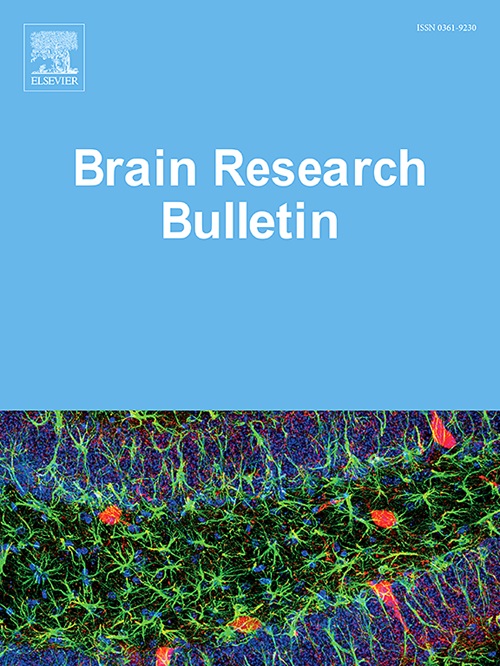IF 3.5
3区 医学
Q2 NEUROSCIENCES
引用次数: 0
摘要
背景:疼痛和抑郁是晚期癌症患者常见的并发症,严重影响患者的生活质量和生存期。中枢神经系统中的JAK/STAT3通路失调与疼痛和脑部炎症性疾病有关,但其在骨癌疼痛(BCP)中的作用仍不清楚。本研究旨在探讨杏仁核中的JAK/STAT3通路在BCP中的特定作用:方法:通过胫骨内注射 MRMT-1 癌细胞建立了 BCP 大鼠模型。方法:通过胫骨内注射 MRMT-1 癌细胞建立 BCP 大鼠模型,用机械戒断阈值评估疼痛行为,用蔗糖偏好和强迫游泳试验评估抑郁样行为。使用Western印迹、免疫荧光和逆转录-定量聚合酶链反应(RT-qPCR)检测了杏仁核中炎症因子和相关蛋白表达水平的变化。评估了杏仁核内注射靶向视黄酸相关孤儿受体γt(RORγt)的慢病毒(LV-shRORγt)、硝呋塞(STAT3 拮抗剂)和可乐定(STAT3 激动剂)的效果:结果:服用 BCP 的大鼠杏仁核小胶质细胞活化增加。杏仁核中 RORγt 基因敲除的大鼠显示出小神经胶质细胞活化水平降低。硝呋沙齐减少了Th17细胞的分化,从而有可能减轻疼痛和抑郁样行为。为了进一步探究JAK/STAT3通路与Th17细胞之间的潜在关系,研究人员同时服用了LV-shRORγt和STAT3激动剂。LV-shRORγt的抑制作用抵消了STAT3激动剂的活性作用:我们的研究表明,通过抑制 Th17 细胞分化,靶向 JAK/STAT3 信号可减轻 BCP 大鼠的疼痛和抑郁样行为。本文章由计算机程序翻译,如有差异,请以英文原文为准。
JAK/STAT3 signaling promotes pain and depression-like behaviors in rats with bone cancer pain by regulating Th17 cell differentiation
Background
Pain and depression are common complications in patients with advanced cancer, which significantly affects their quality of life and survival. Dysregulation of the JAK/STAT3 pathway in the central nervous system is associated with pain and brain inflammatory disorders, but its role in bone cancer pain (BCP) remains unclear. This study aimed to investigate the specific role of the JAK/STAT3 pathway in the amygdala in BCP.
Methods
A BCP rat model was established by intratibial injection of MRMT-1 carcinoma cells. Pain behavior was assessed using the mechanical withdrawal threshold, while depression-like behavior was assessed using the sucrose preference and forced swim test. Changes in inflammatory factors and related protein expression levels in the amygdala were detected using western blotting, immunofluorescence, and reverse transcription-quantitative polymerase chain reaction (RT-qPCR). The effects of intra-amygdala injections of a lentivirus targeting retinoic acid-related orphan receptor γt (RORγt) (LV-shRORγt), nifuroxazide (a STAT3 antagonist), and colivelin (a STAT3 agonist) were evaluated.
Results
Rats with BCP demonstrated increased microglial activation in the amygdala. Rats experiencing RORγt knockout in the amygdala showed reduced microglial activation levels. Nifuroxazide reduced Th17 cell differentiation, potentially alleviating pain and depression-like behaviors. To further explore the underlying relationship between the JAK/STAT3 pathway and Th17 cells, LV-shRORγt and a STAT3 agonist were co-administered. The inhibitory effect of LV-shRORγt counteracted the STAT3 agonist’s active effects.
Conclusions
Our study showed that targeting JAK/STAT3 signaling alleviated pain- and depression-like behaviors in rats with BCP by inhibiting Th17 cell differentiation.
求助全文
通过发布文献求助,成功后即可免费获取论文全文。
去求助
来源期刊

Brain Research Bulletin
医学-神经科学
CiteScore
6.90
自引率
2.60%
发文量
253
审稿时长
67 days
期刊介绍:
The Brain Research Bulletin (BRB) aims to publish novel work that advances our knowledge of molecular and cellular mechanisms that underlie neural network properties associated with behavior, cognition and other brain functions during neurodevelopment and in the adult. Although clinical research is out of the Journal''s scope, the BRB also aims to publish translation research that provides insight into biological mechanisms and processes associated with neurodegeneration mechanisms, neurological diseases and neuropsychiatric disorders. The Journal is especially interested in research using novel methodologies, such as optogenetics, multielectrode array recordings and life imaging in wild-type and genetically-modified animal models, with the goal to advance our understanding of how neurons, glia and networks function in vivo.
 求助内容:
求助内容: 应助结果提醒方式:
应助结果提醒方式:


